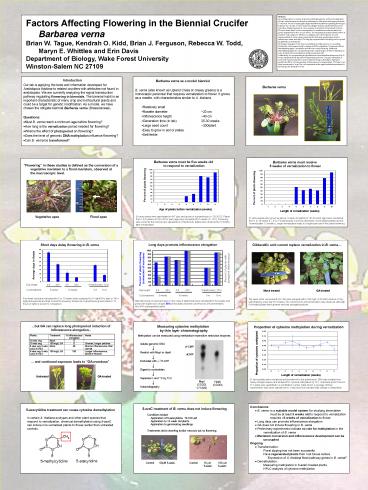Factors Affecting Flowering in the Biennial Crucifer - PowerPoint PPT Presentation
Title:
Factors Affecting Flowering in the Biennial Crucifer
Description:
Abstract An exciting avenue to explore in the post-arabidopsis genome world is the application of tools and information developed in arabidopsis to other plants with ... – PowerPoint PPT presentation
Number of Views:61
Avg rating:3.0/5.0
Title: Factors Affecting Flowering in the Biennial Crucifer
1
Abstract An exciting avenue to explore in the
post-arabidopsis genome world is the application
of tools and information developed in arabidopsis
to other plants with unique attributes. To this
end, our lab is analyzing the signal transduction
pathway regulating flowering in biennials. As a
model, we have chosen the obligate biennial
crucifer Barbarea verna. Like other obligate
biennials, B. verna requires an extended cold
treatment to flower. We have shown that B. verna
is unresponsive to vernalization treatment until
it has grown vegetatively for five or more weeks.
The vernalization treatment itself must be at
least five weeks long to be effective. In
addition to the cold treatment, we have
determined that B. verna requires long-days for
flowering, producing an abortive inflorescence
under short days. The long-day requirement for
flowering can be replaced by gibberellic acid
treatment. Drawing an analogy to work done in
arabidopsis and other species, we are asking
whether the cold treatment leads to changes in
DNA methylation. Treatments with the
demethylating agent 5-azacytidine did not lead to
early flowering. Additional demethylating agents
are currently being tested, and the degree of DNA
methylation in cold- and chemical-treated plants
is being measured directly. Additionally, we are
generating an Agrobacterium-based transformation
protocol for B. verna, using both floral dip and
root regeneration protocols. Our goal is
transform B. verna with constructs known to
induce early flowering in Arabidopsis thaliana to
analyze the effects of overexpression of these
genes in a biennial plant. We hope to use these
experiments to map the cold requirement in the
signal transduction pathway for flowering in the
biennial B. verna.
Factors Affecting Flowering in the Biennial
Crucifer Barbarea verna Brian W.
Tague, Kendrah O. Kidd, Brian J. Ferguson,
Rebecca W. Todd, Maryn E. Whittles and
Erin Davis Department of Biology, Wake Forest
University Winston-Salem NC 27109
-
Introduction - Our lab is applying the tools and information
developed for Arabidopsis thaliana to related
crucifers with attributes not found in
arabidopsis. We are currently analyzing the
signal transduction pathway regulating flowering
in biennials. The biennial habit is an important
characteristic of many crop and horticultural
plants and could be a target for genetic
modification. As a model, we have chosen the
obligate biennial Barbarea verna (Brassicaceae). - Questions
- Must B. verna reach a minimum age before
flowering? - How long is the vernalization period needed for
flowering? - What is the effect of photoperiod on flowering?
- Does the level of genomic DNA methylation
influence flowering? - Can B. verna be transformed?
5-azaC treatment of B. verna does not induce
flowering
5-azacytidine treatment can cause cytosine
demethylation
Conditions tested Application of
5-azacytidine, 10-100 mM Application to gt5
week old plants Application to germinating
seedlings Treatments led to dwarfing and/or
necrosis but no flowering
In certain A. thaliana ecotypes and other plant
species that respond to vernalization, chemical
demethylation using 5-azaC can induce
non-vernalized plants to flower earlier than
untreated controls.
Control 50?M 5-azaC
Control
10 mm 5-azaC
100 mm 5-azaC































